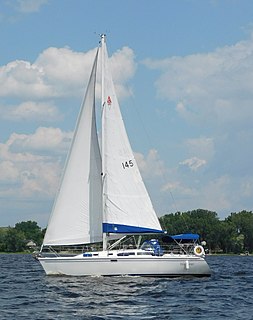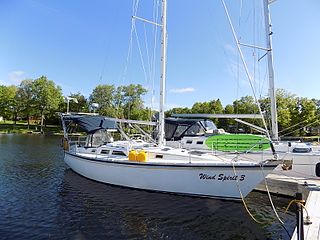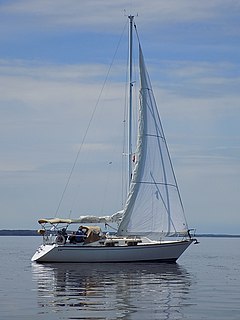
The Catalina 30 is a series of American sailboats, that were designed by Frank Butler and later by Gerry Douglas.
The Newport 30 is an American sailboat, that was designed by Gary Mull and first built in 1968. The design is out of production.
The Newport 33 is an American sailboat, that was designed by Gary Mull and first built in 1971.

The Catalina 34 is an American sailboat designed by Frank V. Butler and first built in 1985. The design is out of production.

The Catalina 320 is an American sailboat, that was designed by Gerry Douglas and first built in 1993.

The C&C 35, also called the Redwing 35, is a Canadian sailboat, that was designed by Cuthbertson & Cassian and first built in 1969.
The CS 40 is a Canadian sailboat, that was designed by Tony Castro and first built in 1987.
The Redline 41 is a series of sailboat designs, first built in 1967 and that remained in production in 2017. The first two designs were by Cuthbertson & Cassian and the more recent one by Mark Mills.
The C&C 121, originally called the 121 Express at introduction, is an American sailboat, that was designed by Tim Jackett and entered production in 1999.

The C&C 29-2, also called the C&C 29 Mark II, is a Canadian sailboat that was designed by Cuthbertson & Cassian as a Midget Ocean Racing Club racer-cruiser and first built in 1983.

The C&C 25 is a series of Canadian sailboats, first built in 1973.

The Hunter 34 is an American sailboat, that was designed by Cortland Steck.
The Hunter 25 is an American trailerable sailboat, designed by John Cherubini and Bob Seidelmann and first built in 1972.

The Catalina 28 is an American sailboat, that was designed by Gerry Douglas and first built in 1991.

The Tartan 34-2 is an American sailboat, that was designed by Sparkman & Stephens and first built in 1984.
The C&C 36-1 is a Canadian sailboat that was designed by C&C Design and first built in 1977.
The C&C 37 is a Canadian sailboat, that was designed by Robert W. Ball of C&C Design and first built in 1981.
The Nonsuch 324 is a Canadian sailboat, that was designed by Mark Ellis Design and first built in 1994. It was the last of the series of Nonsuch sailboats built.
The Nonsuch 33 is a Canadian sailboat, that was designed by Mark Ellis Design and first built in 1988.
The Hunter 33 is an American sailboat that was designed by John Cherubini and first built in 1977.














